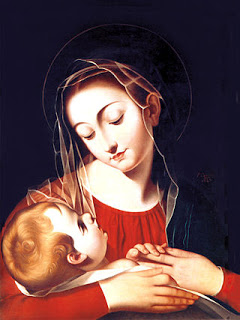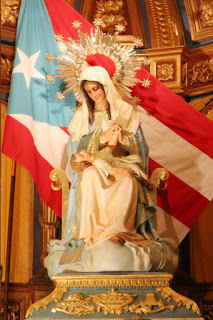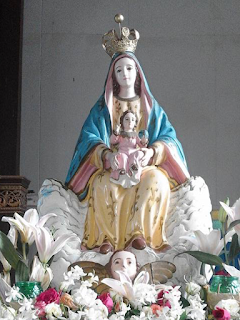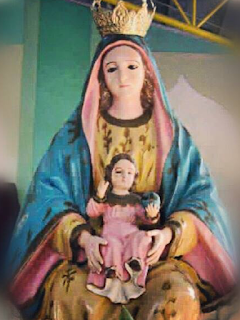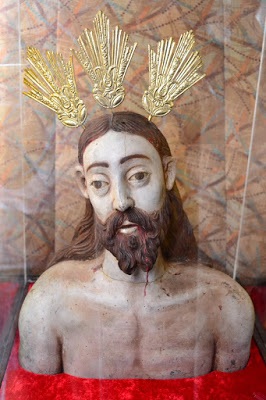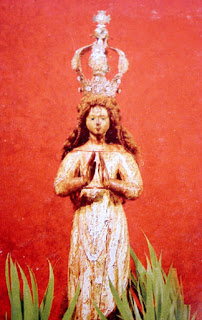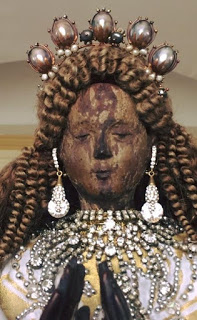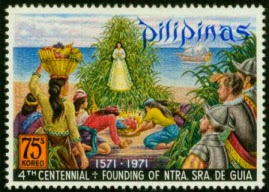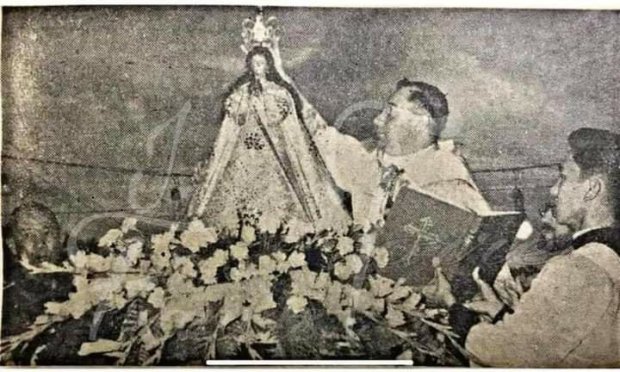
As part of a national movement of the Church for a call for prayer to end the COVID-19 pandemic that took lives of millions of people world wide, every Wednesdays, the “Healing Rosary for the World” is held in different Cathedrals and Shrines all over the country that are streamed online. In one of the stops. a certain Marian image caught the attention of many for this image was never before seen by the public – at least for now. This image is the beautiful painting of Our Lady of the Mission venerated in the Chapel of the Divine Word Seminary in Tagaytay City, Cavite. The painting caught the attention of Marian devotees in social media and it is evident to the number of views on the day of its healing rosary streaming. Now its time to get to know more about her and appreciate its meaning and message.

The painting
The beautiful painting of Our Lady of the Mission depicts the Blessed Mother holding the Child Jesus in her arms while covering the people under her mantle. The painting was set in a beautiful scenery of Tagaytay with the view of the Binintiang Malaki (which is commonly mistaken as the Taal Volcano) on the right while the Divine Word Seminary is situated on the hilly side of Tagaytay on the left. In this painting, the Virgin wears a white robe, a large blue cape/mantle with gold trimmings on the neckline, wears a crown on top of her beautiful long wavy hair while the Child Jesus wears a red robe and a golden tunic on His waist.
The painting also depicts 3 saints and a unidentified missionary sister (could have been the painter as I will discuss later) namely St. Therese of the Child Jesus, the Patroness of the Missions (although she never left the cloisters of the Discalced Carmelite convent in Lisieux, France, she desired to be part of the a Carmelite Mission that will be established in Vietnam yet this was hindered due to her bouts with tuberculosis, hence she resolved to assist the Missionaries with her prayers ans sacrifices as their “spiritual sister”) on the left with the unidentified missionary sister while on the right it depicts St. Arnold Jansssen, Founder of the Society of the Divine Word and St. Joseph Freinademetz, the Society’s foremost missionary due to this successful missionary work in China (hence he wears a Chinese costume).
The painting of Our Lady of the Mission depicts the Madonna and Child in the Schutzmantel iconography: The Blessed Mother, in this case holding the Child Jesus and the faithful were under her mantle of protection. For this Schutzmantel Madonna painting, it shows the Blessed Mother covering under her mantle to the children from different nations and continents in the world, which also represent the nations where the Society of the Divine Word established their missions centers. The Child Jesus on the other hand looks down on the people under her Mother’s mantle and even holding the right side of it to help cover the people.
The Society of the Divine Word
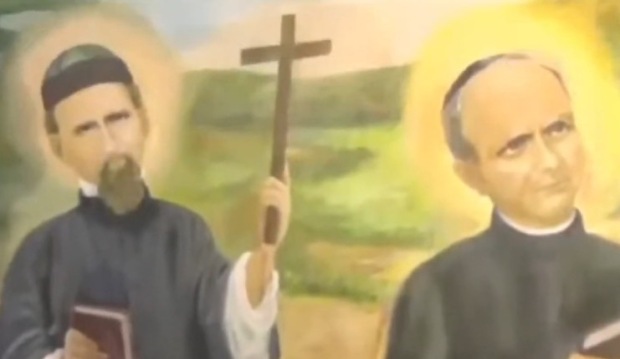
Given with the depiction of the two foremost saints of the Society of the Divine Word, it is just proper to give a sort of a background of this famed mission society. The Society was founded in Steyl in the Netherlands in 1875 by St. Arnold Janssen, a diocesan priest and a Dominican ertiary, and drawn mostly from German priests and religious exiles in the Netherlands during the church-state conflict called the Kulturkampf, which had resulted in many religious groups being expelled and seminaries being closed in Germany.
In 1882, the Society started sending missionaries across the globe and as of 2020, it consisted of 6,023 members composed of priests and religious brothers working in more than 70 countries which make the society the largest missionary congregation in the Catholic Church. The Society arrived in the Philippines in Bangued, Abra, in 1909, founding schools in Bangued, Vigan, in Ilocos Sur and Laoag City in Ilocos Norte, as well as in other parts of the Philippines. Now there are about 500 Filipino SVD priests and brothers and around 150 of them are serving in overseas missions on all continents. The Society also established a publishing center, Logos publications and a media arm to further expand their efforts on evangelization.
History
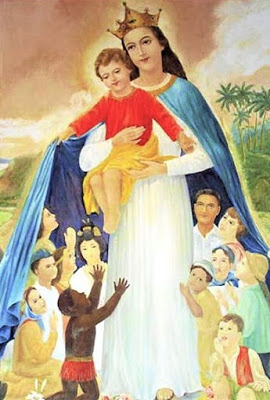
The origin of the painting came through when Rev. Fr. Antolin Uy, SVD was travelling for his missionary work and during his stop in Spain, he saw a painting of the Blessed Mother in the Schutzmantel iconography with children from other parts of the world under her mantle. Fr. Uy also saw a similar painting of the Virgin with the same Schutzmantel iconography, this time with people representing the Society’s missions in different countries around the world.
Because of these events, he was inspired to have a similar image to be commissioned for the Philippines missions. Fr. Uy commissioned Sister Eliesea Quinto of the Franciscan Missionaries of Mary to paint the image in 1985 and it was enshrined at the Divine Word Seminary Chapel in Tagaytay for veneration of the society’s priests and student brothers. The image appeared in numerous publications of the Society and recently, on August 19, 2020, Filipino Marian devotees thru social media got a glimpse of the beautiful painting of Our Lady of the Mission for its first public appearance to implore her help to end the COVID-19 pandemic.
The Mysteries of Mission
A unique Marian devotion to honor Our Lady of the Mission was developed and introduced by the Society called “The Mysteries of Mission” on October 20, 2020 , World Mission Sunday during the Year of the Rosary (Proclaimed by Pope St. John Paul II where he introduced the Luminous Mysteries of St. George Preca of Malta). These set of mysteries were formed as an invitation to deeper contemplation and humility to allow Our Lord through Our Lady to lead people enkindle the spirit of all missionaries worldwide and enrich their mission spirituality.
The following are the Mysteries of Mission:
- The Incarnation
- The Epiphany
- The Calling of the Twelve Apostles
- The Washing of the feet
- The Mission sending of the Disciples to the World.
The Mysteries of Mission is prayed every Tuesdays in honor of Our Lady of the Mission and it is also prayed in the month of October, the month of the Rosary and mission, especially on ‘World Mission Sunday”, “Church Unity Octave”, “Vocation Awareness Week”, “Mission Week”, on certain feasts like the feasts of the Epiphany, the feasts of the apostles and missionary saints, martyrs and blessed servants of God like those feast of St. Arnold Janssen (January 15), St. Joseph Freinademetz (January 29), Blessed Maria Helena Stollenwerk (November 28), St. Therese of the Child Jesus – Patroness of Missions (October 1), St. Francis Xavier – Patron of Missions (December 3).

The devotion
The devotion to Mary as the Lady and Mother of Missions is quite unique yet important , especailly to our missionaries. Pope Francis has stated that Our Lady provides us with the best example of a missionary. First,because she brought love into the world through the birth of Christ, but also because, by following her virtues, we will be better able to bring God’s love to others. Let us ask Our Blessed Mother, Our Lady of the Missions to help our missionaries in their evangelizing work and for the conversion on non-believers so that all will be united under One True Church, One Savior, One God.
Our Lady of the Mission, pray for us!
References:
Hermann Fischer, Life of Arnold Janssen. Founder of the Society of the Divine Word and the Missionary Congregation of the Servants of the Holy Ghost, translated by Frederic M. Lynk, Mission Press S.V.D.: Techny, Illinois/USA 1925.
The Mysteries of the Mission : Praying the Rosary with One Heart as Missionaries, Second Edition, Logos Publications, Manila, 2004.
Fritz Bornemann, A History of the Divine Word Missionaries, Rome 1981.
Images that are used for this blogpost is taken from the Healing Rosary for World Live streaming broadcast streamed on August 19, 2020.
+AM+DG+
+AMPSPC+





